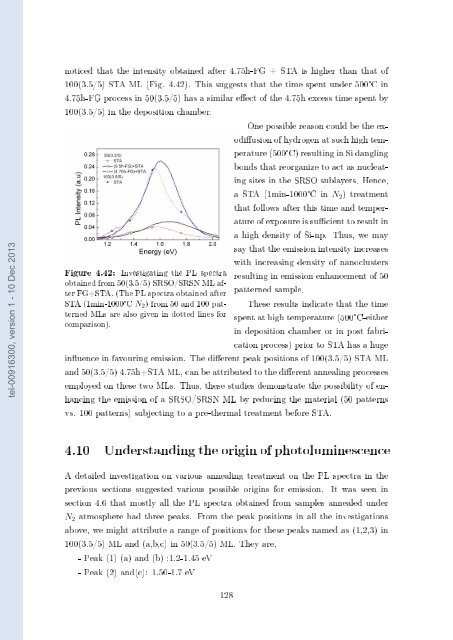Films minces à base de Si nanostructuré pour des cellules ...
Films minces à base de Si nanostructuré pour des cellules ...
Films minces à base de Si nanostructuré pour des cellules ...
You also want an ePaper? Increase the reach of your titles
YUMPU automatically turns print PDFs into web optimized ePapers that Google loves.
tel-00916300, version 1 - 10 Dec 2013<br />
noticed that the intensity obtained after 4.75h-FG + STA is higher than that of<br />
100(3.5/5) STA ML (Fig. 4.42). This suggests that the time spent un<strong>de</strong>r 500 °C in<br />
4.75h-FG process in 50(3.5/5) has a similar eect of the 4.75h excess time spent by<br />
100(3.5/5) in the <strong>de</strong>position chamber.<br />
Figure 4.42: Investigating the PL spectra<br />
obtained from 50(3.5/5) SRSO/SRSN ML after<br />
FG+STA. (The PL spectra obtained after<br />
STA (1min-1000°C N 2 ) from 50 and 100 patterned<br />
MLs are also given in dotted lines for<br />
comparison).<br />
One possible reason could be the exodiusion<br />
of hydrogen at such high temperature<br />
(500°C) resulting in <strong>Si</strong> dangling<br />
bonds that reorganize to act as nucleating<br />
sites in the SRSO sublayers. Hence,<br />
a STA (1min-1000°C in N 2 ) treatment<br />
that follows after this time and temperature<br />
of exposure is sucient to result in<br />
a high <strong>de</strong>nsity of <strong>Si</strong>-np. Thus, we may<br />
say that the emission intensity increases<br />
with increasing <strong>de</strong>nsity of nanoclusters<br />
resulting in emission enhancement of 50<br />
patterned sample.<br />
These results indicate that the time<br />
spent at high temperature (500°C-either<br />
in <strong>de</strong>position chamber or in post fabrication<br />
process) prior to STA has a huge<br />
inuence in favouring emission. The dierent peak positions of 100(3.5/5) STA ML<br />
and 50(3.5/5) 4.75h+STA ML, can be attributed to the dierent annealing processes<br />
employed on these two MLs. Thus, these studies <strong>de</strong>monstrate the possibility of enhancing<br />
the emission of a SRSO/SRSN ML by reducing the material (50 patterns<br />
vs. 100 patterns) subjecting to a pre-thermal treatment before STA.<br />
4.10 Un<strong>de</strong>rstanding the origin of photoluminescence<br />
A <strong>de</strong>tailed investigation on various annealing treatment on the PL spectra in the<br />
previous sections suggested various possible origins for emission. It was seen in<br />
section 4.6 that mostly all the PL spectra obtained from samples annealed un<strong>de</strong>r<br />
N 2 atmosphere had three peaks. From the peak positions in all the investigations<br />
above, we might attribute a range of positions for these peaks named as (1,2,3) in<br />
100(3.5/5) ML and (a,b,c) in 50(3.5/5) ML. They are,<br />
- Peak (1) (a) and (b) :1.2-1.45 eV<br />
- Peak (2) and(c): 1.50-1.7 eV<br />
128
















